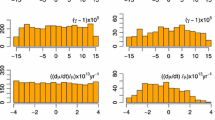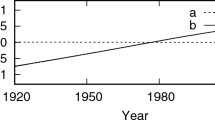Abstract
The EPM (Ephemerides of Planets and the Moon) numerical ephemerides were first created in the 1970s in support of Russian space flight missions and since then have been constantly improved at IAA RAS. In the following work, the latest version of the planetary part of the EPM2011 numerical ephemerides is presented. The EPM2011 ephemerides are computed using an updated dynamical model, new values of the parameters, and an extended observation database that contains about 680000 positional measurements of various types obtained from 1913 to 2011. The dynamical model takes into account mutual perturbations of the major planets, the Sun, the Moon, 301 massive asteroids, and 21 of the largest trans-Neptunian objects (TNOs), as well as perturbations from the other main-belt asteroids and other TNOs. The EPM ephemerides are computed by numerical integration of the equations of motion of celestial bodies in the parameterized post-Newtonian n-body metric in the BCRS coordinate system for the TDB time scale over a 400-year interval. The ephemerides were oriented to the ICRF system using 213 VLBI observations (taken from 1989 to 2010) of spacecraft near planets with background quasars, the coordinates of which are given in the ICRF system. The accuracy of the constructed ephemerides was verified by comparison with observations and the JPL independent ephemerides DE424.
The EPM ephemerides are used in astronavigation (they form the basis of the Astronomical Yearbook and are planned to be utilized in GLONASS and LUNA-RESURS programs) and various research, including the estimation of the solar oblateness, the parameters of the rotation of Mars, and the total mass of the asteroid main belt and TNOs, as well as the verification of general relativity, the secular variations of the Sun’s mass and the gravitational constant, and the limits on the dark matter density in the Solar System.
The EPM ephemerides, together with the corresponding time differences TT — TDB and the coordinates of seven additional objects (Ceres, Pallas, Vesta, Eris, Haumea, Makemake, and Sedna), are available at ftp://quasar.ipa.nw.ru/incoming/EPM.
Similar content being viewed by others
References
Akim, E.L., Brumberg, V.A., Kislik, M.D., et al., A relativistic theory of motion of inner planets, in Proc. 114th IAU Symp. Relativity in Celestial Mechanics and Astrometry, Kovalevsky, J. and Brumberg, V.A., Eds., Dordrecht: Kluver Acad. Publ., 1986, pp. 63–68.
Aleshkina, E.Yu., Krasinsky, G.A., and Vasilyev, M.V., Analysis of LLR data by the program system ERA, in Proc. 165th IAU Coll. Dynamics and Astrometry of Natural and Artificial Celestial Bodies, Wytrzyszczak, I.M., Lieske, J.H., and Feldman, R.A., Eds., Dordrecht: Kluwer Acad. Publ., 1997, pp. 227–238.
Brattseva, O.A., Novikov, F.A., Pitjeva, E.V., et al., Software support of IAA planetary and the Moon ephemerides, Trudy Inst. Prikl. Astron. Russ. Akad. Nauk, 2010, vol. 21, pp. 201–204.
Fienga, A., Manche, H., Laskar, J., and Gastineau, M., INPOP06: a new numerical planetary ephemeris, Astron. Astrophys., 2008, vol. 477, pp. 315–327.
Fienga, A., Laskar, J., Kuchynka, P., et al., The INPOP10a planetary ephemeris and its applications in fundamental physics, Celest. Mech. Dyn. Astron., 2011, vol. 111, pp. 363–385.
Folkner, M.W., Planetary ephemeris DEF423 fit to messenger encounters with mercury, JPL Interoffice Memorandum, Pasadena, 2010, vol. 343-10-001, pp. 1–15.
Hilton, J.L. and Hohenkerk, C.Y., A comparison of the high accuracy planetary ephemeredes DE421, EPM2008, and INPOP08, in Systems de reference spatio-temporels. Journees-2010, Capitaine, N., Ed., Observatorie de Paris, 2011, pp. 77–80.
Jones, D.L., Fomalont, E., Dhawan, V., et al., Very long baseline array astrometric observations of the Cassini spacecraft at Saturn, Astron. J., 2011, vol. 141,issue 2.
Klioner, S.A., Gerlach, E., and Soffel, M.H., Relativistic aspects of rotational motion of celestial bodies, in Proc. 165th IAU Symp. Giant Step: from Millito Micro-Arc-second Astrometry, Klioner, S.A., Seidelmann, P.K., and Soffel, M., Eds., Cambridge Univ., 2010, pp. 112–123.
Konopliv, A.S., Asmar, S.W., Folkner, W.M., et al., Mars high resolution gravity field from MRO, Mars seasonal gravity, and other dynamical parameters, Icarus, 2011, vol. 211, pp. 401–428.
Krasinsky, G.A., Aleshkina, E.Yu., Pitjeva, E.V., and Sveshnikov, M.L., Relativistic effects from planetary and lunar observations of the XVIII-XX centuries, in Proc. 114th IAU Symp. Relativity in Celestial Mechanics and Astrometry, Kovalevsky, J. and Brumberg, V.A., Eds., Dordrecht: Kluver Acad. Publ., 1986, pp. 315–328.
Krasinsky, G.A., Pitjeva, E.V., Sveshnikov, M.L., and Chunajeva, L.I., The motion of major planets from observations 1769-1988 and some astronomical constants, Celest. Mech. Dyn. Astron., 1993, vol. 55, pp. 1–23.
Krasinsky, G.A. and Vasilyev, M.V., ERA: knowledge base for ephemeris and dynamic astronomy, in Proc. 165th IAU Coll. Dynamics and Astrometry of Natural and Artificial Celestial Bodies, Wytrzyszczak, I.M., Lieske, J.H., and Feldman, R.A., Eds., Dordrecht: Kluwer Acad. Publ., 1997, pp. 239–244.
Krasinsky, G.A., Selenodynamical parameters from analysis of LLR observations of 1970–2001, Commun. IAA RAS, 2002a, vol. 148, pp. 1–27.
Krasinsky, G.A., Pitjeva, E.V., Vastlyev, M.V., and Yagudina, E.I., Hidden mass in the asteroid belt, Icarus, 2002b, vol. 158, pp. 98–105.
Luzum, B., Capitane, N., Fienga, A., et al., The IAU 2009 systems of astronomical constants: the report of the IAU working group on numerical standards for fundamental astronomy, Celest. Mech. Dyn. Astron., 2011, vol. 110, pp. 293–304.
Pitjev, N.P. and Pitjeva, E.V., Constraints on dark matter in the solar system, Astron. Lett., 2013, vol. 39, no. 3, pp. 141–149.
Pitjeva, E.V., Experimental testing of relativistic effects, variability of the gravitational constant and topography of mercury surface from radar observations 1964–1989, Celest. Mech., 1993, vol. 55, pp. 313–321.
Pitjeva, E.V., ERM98: the new numerical motion theory for planets and its comparison with DE403 ephemerede of Jet Propulsion Laboratory, Trudy Inst. Prikl. Astron. Russ. Akad. Nauk, 1998, vol. 3, pp. 5–23.
Pitjeva, E.V., Study of Mars dynamics from analysis of Viking and Pathfinder lander radar data, Trudy Inst. Prikl. Astron. Russ. Akad. Nauk, 1999, vol. 4, pp. 22–35.
Pitjeva, E.V., Modern numerical ephemerides of planets and the importance of ranging observations for their creation, Celest. Mech. Dyn. Astron., 2001, vol. 80, pp. 249–271.
Pitjeva, E.V., High-precision ephemeredes of planets-EPM and determination of some astronomical constants, Solar Syst. Res., 2005a, vol. 39, no. 3, pp. 176–186.
Pitjeva, E.V., Relativistic effects and solar oblateness from radar observations of planets and spacecraft, Astron. Lett., 2005b, vol. 31, no. 5, pp. 340–349.
Pitjeva, E.V., Highly accurate planetary ephemeredes of IAA RAS-EPM2008 and their orientation in ICRF system, Trudy Inst. Prikl. Astron. Russ. Akad. Nauk, 2009, vol. 20, pp. 463–466.
Pitjeva, E.V. and Standish, E.M., Proposalls for the masses of the three largest asteroids, the Moon-Earth mass ratio and the astronomical unit, Celest. Mech. Dyn. Astron., 2009, vol. 103, pp. 365–372.
Pitjeva, E.V., EPM ephemeredes and relativity, in Proc. 165th IAU Symp. Giant Step: from Millito Micro-Arcsecond Astrometry, Klioner, S.A., Seidelmann, P.K., and Soffel, M., Eds., Cambridge: Univ. Press, 2010a, pp. 170–178.
Pitjeva, E.V., Influence of asteroids and trans-Neptunian objects of major planets and masses of the asteroid main belt and TNO ring, Proc. Int. Conf. Asteroid-Comet Hazard-2009, Finkelstein, A., Huebner, W., and Shor, V., Eds., St. Petersburg: Nauka, 2010b, pp. 237–241.
Pitjeva, E.V., Fundamental national ephemeredes of planets and the Moon (EPM) by the Institute of Applied Astronomy of the Russian Academy of Sciences: dynamical model, parameters, accuracy, Trudy Inst. Prikl. Astron. Russ. Akad. Nauk, 2012, vol. 23, pp. 149–157.
Pitjeva, E.V. and Pitjev, N.P., Changes in the Sun’s mass and gravitational constant estimated using modern observations of planets and spacecraft, Solar Syst. Res., 2012, vol. 46,no. 1, pp. 78–87.
Poroshina, A., Kosmodamianskiy, G., and Zamarashkina, M., Construction of the numerical motion theories for the main satellites of Mars, Jupiter, Saturn, and Uranus in IAA RAS, Proc. JENAM-2011, St. Petersburg, 2011, pp. 75–87.
Russell, C.T., Raymond, C.A., Coradini, C.A., et al., Dawn at Vesta: testing the proto-planetary paradigm, Science, 2012, vol. 336, pp. 684–686.
Standish, E.M., Newhall XX, Williams, J.G., and Folkner, W.M., JPL planetary and lunar ephemerides, DE403/LE403, JPL Interoffice Memorandum, Pasadena, 1995, vol. 314, pp. 1–22.
Standish, E.M., JPL planetary and lunar ephemerides, DE405/LE405, JPL Interoffice Memorandum, Pasadena, 1998, vol. 312.F-98-048, pp. 1–18.
Standish, E.M. and Fienga, A., Accuracy limit of modern ephemerides imposed by the uncertainties in asteroid masses, Astron. Astrophys., 2002, vol. 384, pp. 322–328.
Standish, E.M., An approximation to the errors in the planetary ephemerides of the Astronomical Almanac, Astron. Astrophys., 2004, vol. 417, pp. 1165–1171.
Williams, J.G., Determining asteroid masses from perturbations on Mars, Icarus, 1984, vol. 57, pp. 1–13.
Williams, J.G., Harmonic analysis, Bull. Am. Astron. Soc., 1989, vol. 21, pp. 1009–1010.
Yagudina, E.I., Krasinsky, G.A., and Prokhorenko, S.O., EPM-ERA ephemeride of the Moon and selenodynamical parameters from LLR observations processing, Trudy Inst. Prikl. Astron. Russ. Akad. Nauk, 2012, vol. 23, pp. 165–171.
Yoder, C.F. and Standish, E.M., Martian precession and rotation from Viking lander range data, J. Geophys. Res., 1997, vol. 102, pp. 4065–4080.
Author information
Authors and Affiliations
Additional information
Original Russian Text © E.V. Pitjeva, 2013, published in Astronomicheskii Vestnik, 2013, Vol. 47, No. 5, pp. 419–435.
Rights and permissions
About this article
Cite this article
Pitjeva, E.V. Updated IAA RAS planetary ephemerides-EPM2011 and their use in scientific research. Sol Syst Res 47, 386–402 (2013). https://doi.org/10.1134/S0038094613040059
Received:
Published:
Issue Date:
DOI: https://doi.org/10.1134/S0038094613040059




